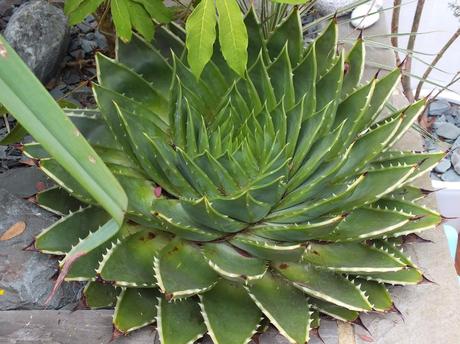
Aloe polyphylla
So what about the planting scheme of this area? Well here's a bit more about the plants, design, and planting scheme.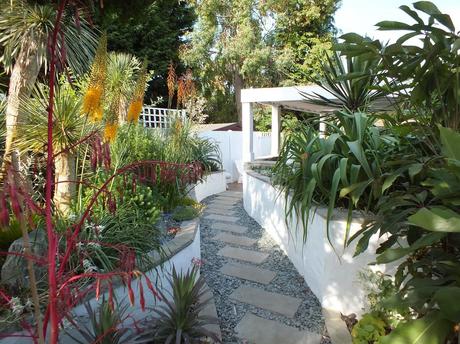
First of all, the planting scheme was never meant to look 'naturalistic'. From the very beginning we never intended the area to resemble 'somewhere else', unlike our old garden which was shaped to give the illusion of being in the tropics. Although we've heard some feedback that this section reminded them of Greece, which is fine too given the white color scheme, presence of Yuccas, and on the photos some sun. However this area reminds us personally of nowhere else but...our own garden.
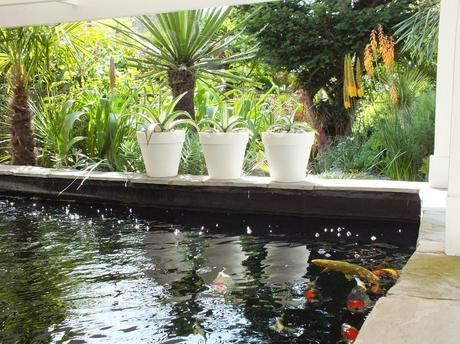
Initially, neither of us wanted to categorise the design style of this area but for convenience of description we regard it as a modern/contemporary, urban garden. It is very structural with the raised pond, water feature, three raised beds, filtration house and decking, and does not hide the fact that it is a town/city garden. Modern gardens and those usually found in urban locations are styles we both love, appreciate, and celebrate.
And being a modern/contemporary, urban garden, there is berth and allowance with regards to the selection of plants and planting scheme. You can be a bit more risque, avant garde, and adventurous. The plants selected were combined together for their form, colour, and texture rather than in lumps and categories like spikies, lush, alpines, and so much more.
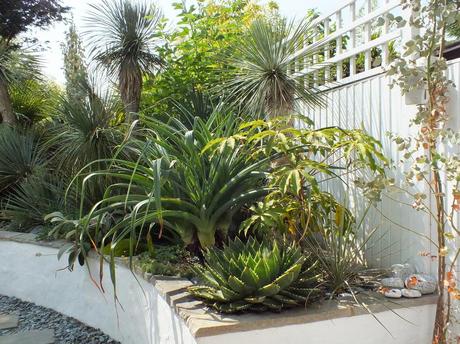
Schefflera and Aloe, not normally combined together but why not?
But whatever planting scheme you wish to go for the main thing you must consider are the growing requirements of plants you wish to use. In an extreme analogy you wouldn't plant a sun loving agave and shade loving aspidistra on the same bed, even if the intention is to have a wacky, avant garde garden. Totally unrealistic combo wherein one will thrive and one will die.In a modern garden you can be experimental and unconventional with your planting scheme as well as defy traditional, pre tried and tested combinations. Some plants traditionally or naturally don't associate with each other but if their growing requirements are actually similar and they may possibly be able to thrive equally well when planted together in the same bed then go for it and experiment. Even if putting them together seems 'unnatural' if you're brave enough still go for it, as long as you feel it is still pleasing to the eye. Sounds fun don't you think so?
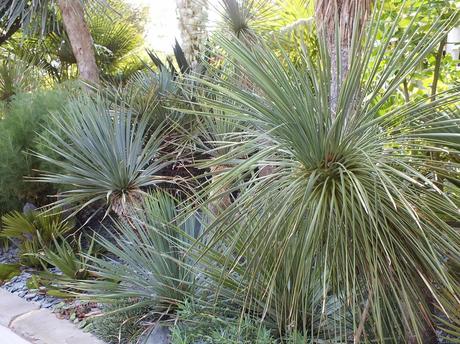
Ok, on to our planting beds...
To prevent any of the beds being labelled as just arid, woodland, rock, etc.; and to stick with the brief of colour, form, and texture we minimised the selection that will go in it.
For example, strictly only one type of aloe (Aloe polyphylla) and agave (Agave bracteosa) will go on the beds. Blue trunked Yuccas will only go on one bed while the other bed will have a green trunked yucca as its main feature. Linking plants will also be used to tie in the beds to each other like Kniphofia caulescens, Scheffleras, and again Aloe polyphylla.
Also, to demarcate this area from our original garden we made a list of plants to avoid repeating in this new area like cannas, bananas, tree ferns, persicarias, and many more.
So there are three planting beds and each planting bed has their own unique conditions, due to their position and the consequent amount of sun it receives through the course of a day.
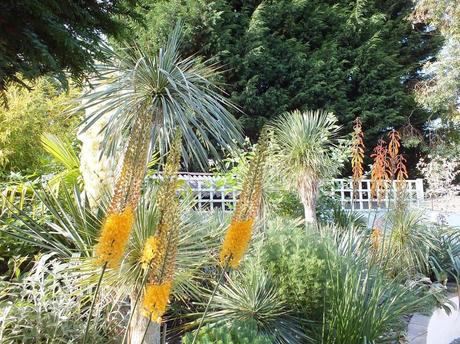
First Raised Bed
The first raised bed, the biggest of the three is in full sun for most of the day and benefits from getting some sunlight during the winter months too. Perfect for sun worshipping and drought tolerant plants. The color scheme of this bed is blue and green, and the texture is matte which to a degree will be mirrored by the second raised bed in front of it.
Blue plants and blue Yuccas
Hence all the tall and blue yuccas are on this bed, plants with matte foliage, as well as green but sun loving plants. Green slate (which actually looks more Light Blue than Green) was used as mulching to reinforce the blue theme as well as boulders of green slate of varying sizes placed throughout the bed serving as natural sculptures. Dotted in amongst the bigger plants are various low growing alpines to give more interest (i.e a good reason to squeeze in more plants!).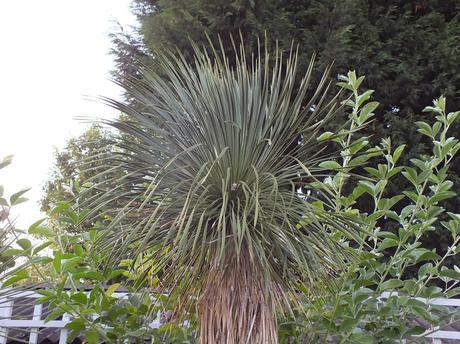
Yucca linearifolia
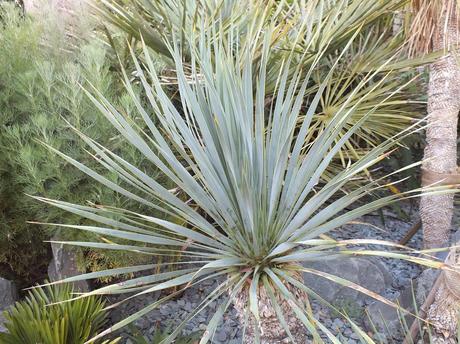
Yucca rostrata
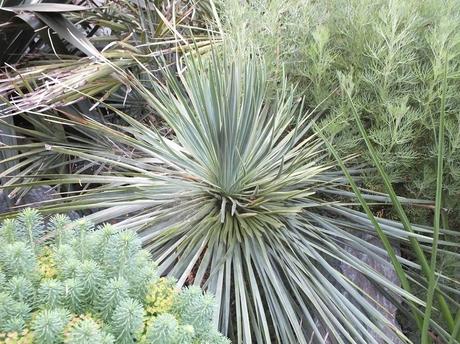
Yucca linearifolia 'Galeana' (?)
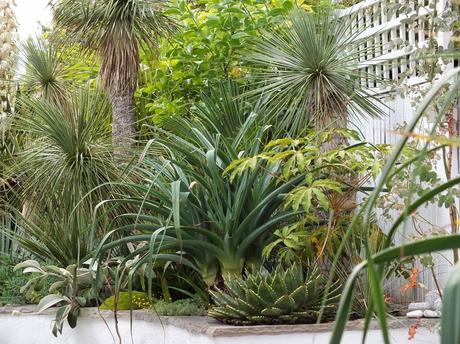
Some of the plants on this bed are Trachycarpus wagnerianus, Tracycarpus fortunei, Yucca linearifolia, Yucca rostrata, Dasylirion wheeleri, Aloe polyphylla, Schefflera rhododendrifolia (has matte foliage), Agave bracteosa, Pachystegia insignis, Cytisus battandieri, Chamaerops humilis 'Vulcano', Kniphofia caulescens,...just to name a few.
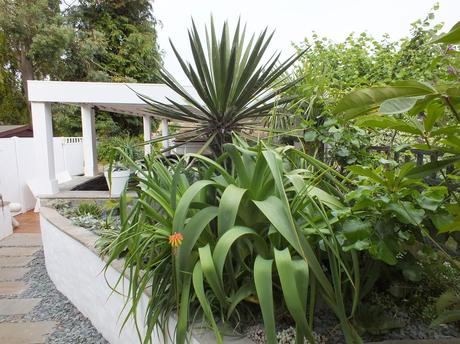
Second Raised Bed
The second raised bed, two thirds of which towards the pathway pretty much has the same conditions as the first raised bed. The remaining third, towards the back is shady as our neighbour's garden has some shrubs and low growing trees planted near this bed. To mirror the color scheme and texture of the first raised bed, the blue, green, and matte theme continues via the use of the same green slate mulch and boulders, as well as use of more matte/blue/silvery plants.
However this bed leans more towards green and the back section planted with lush and leafy plants to plant to make it blend better with plants growing on our neighbours property (also to serve as screening).
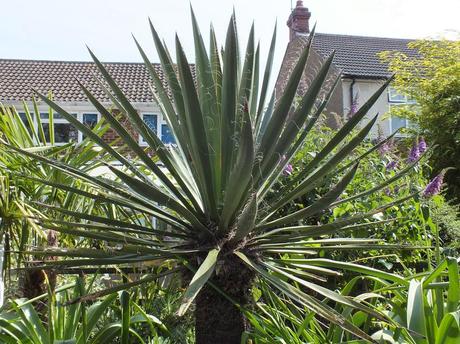
Yucca treculeana
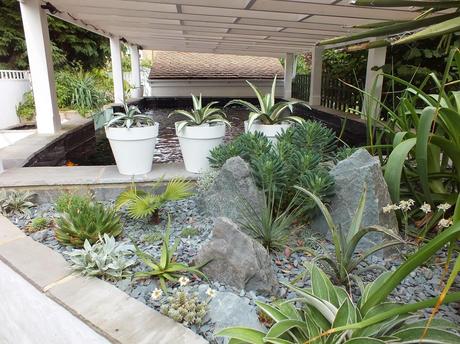

Knophofia northiae
Hence the centrepiece plant on this bed is a tall green leafed yucca, Yucca treculeana. Linking plants are Aloe polyphylla, Schefflera rhododedrifolia (Garden House), Trachycarpus fortunei, and Agave bracteosa. In this bed you will also find Celmisia spectabilis, Celmisia hookeri, Yucca baccata, Kniphofia northiae,...just to name a few.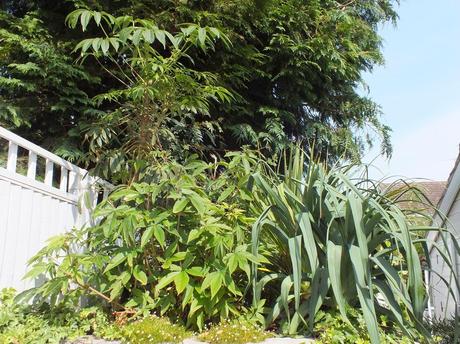
Third Raised Bed
The third raised bed, the smallest of the three and the one connected to the small water feature is mostly under a very tall conifer and only the part nearest to the water feature gets lots of sun, the rest is shady. Schefflera taiwaniana is used as a linking plant as well as Kniphofia caulescens (also echos the blue and matte theme of the other two beds).

Schefflera delavayi
Due to the shady conditions on this bed, a dense miniature woodland planting was chosen that was also inspired by some of the plant stands we see on fairs and flower shows. Green slate would not look right with woodland planting but bark chips won't be any good either as they are likely to be blown away on windy days straight into the koi pond. So Cocoa mulch is used, although very lightweight at first they do fuse together and form a tight mulch once it is moistened (not to mention it has gorgeous chocolate scent which lasts for days).
From one Kniphofia caulescens to another
In this bed you will find Rubus lineatus, Schefflera delavayi, Colocasia gaoliogongaensis, Begonia emeiensis, Cordyline australis, Disporum longistylum, Disporum cantoniense 'Green Giant', Disporum cantoniense, ....just to name a few.Whew! So there you go, a bit of explanation on the design, plants and planting scheme surrounding our new koi pond.
BTW, none of the plants here are protected in the winter.
Mark :-)

